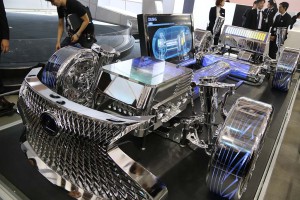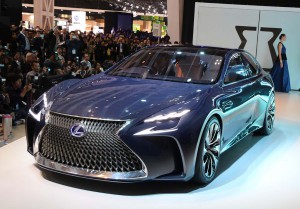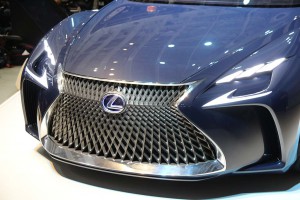Luxury brand Lexus has rolled out a number of concept vehicles in recent years but, with only a few, rare exceptions, they’ve been little more than fantasies in chrome. But the new Lexus LF-LC unveiled at the Tokyo Motor Show on Wednesday is likely to be one of those exceptions.
From a design standpoint, what you see is likely to be – close to — what you’ll get with the next-generation Lexus LS sedan, a senior official told TheDetroitBureau.com. Whether we’ll also see such features as gesture-control electronics and a “hologram guide,” never mind the hydrogen fuel-cell drivetrain, well, that’s another matter entirely
The luxury arm of Toyota is “constantly striving to deliver awe-inspiring experiences,” said Tokuo Fukuichi, Lexus International President, as the current rolled back to reveal the LF-LC Concept vehicle.
Like the current LS, the LF-LC is a full-size sedan, but it boasts a far more dynamically sculpted shape, in line with several other recent Lexus concepts. And it takes the brand’s signature spindle grille to an even bolder level than we’ve seen on recent models like the Lexus GS and RX.
And that’s a bit of an irony considering the LF-LC concept is designed to run on a hydrogen fuel-cell stack, much like the one in the recently launched Toyota Mirai. The technology combines the lightweight gas with oxygen to produce a flow of current – and nothing but water vapor in its exhaust. A fuel cell system really wouldn’t need the big grille to let its powertrain breathe, or to keep it cool.
(You may barely recognize the cars of 2030. Click Here to see why.)
While Mirai puts an emphasis on clean, fuel-efficient driving, the Lexus LF-LC also was designed to deliver the sort of sporty driving luxury buyers expect. While officials declined to provide specific performance and horsepower numbers, they noted that the drivetrain is primarily biased towards the rear wheels. But, in an unusual move, it also uses two hub motors, one in each of the front wheels.
That approach creates a sort of through-the-road all-wheel-drive system that also would permit a very efficient form of torque vectoring to improve handling. “Our vision of the future of mobility means safety, efficiency and freedom,” said Fukuichi.
To offset the added unsprung weight of those motors, meanwhile, the wheels are made of carbon fiber-reinforced plastic. CFRP, one can assume, might be used in other areas of the vehicle to reduce weight.
Technology is the watchword for the Lexus LF-LC concept, and that takes in everything from the distinctive LED headlamps to the gesture control system used to operate the show car’s infotainment and climate control systems. Gesture technology made it into production this year with the launch of the 2016 BMW 7-Series, but owners have found it takes a bit of practice to get hand movements right. The Lexus LF-LC coaches you using a holographic display on the center stack.
(Click Here for a review of the new BMW 7-Series.)
Will we see these go into production? “This vehicle is all about the next 10 years at Lexus,” said Fukuichi, noting that the brand is just celebrating its 10th anniversary on the Japanese market.
(Toyota, Nissan and Honda team up to help create a “hydrogen society.” Click Here for more.)
As for the design, Lexus was careful to make sure the coupe-like design of the LF-LC maintained plenty of head, leg and shoulder room for both front and rear-seat passengers. The cabin features the usual mix of upscale materials and the refinement levels Lexus is known for.
What does it all mean for the future, especially as the current Lexus LS approaches the end of its lifecycle?
“Look at this (concept) and you’ll get a real good idea of where we’re going with the styling direction of the brand,” the LS in particular, Mark Templin, a Managing Officer at Toyota and Executive Vice President of Lexus International, told TheDetroitBureau.com.




